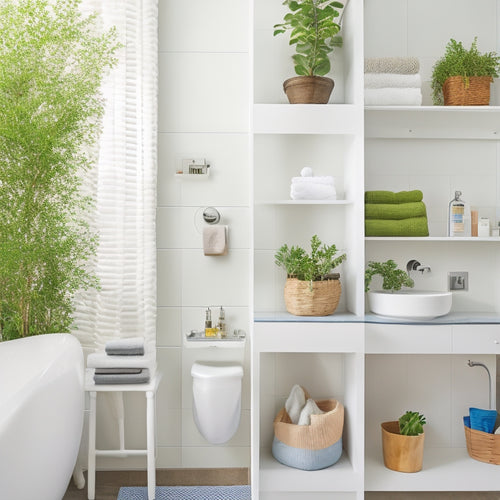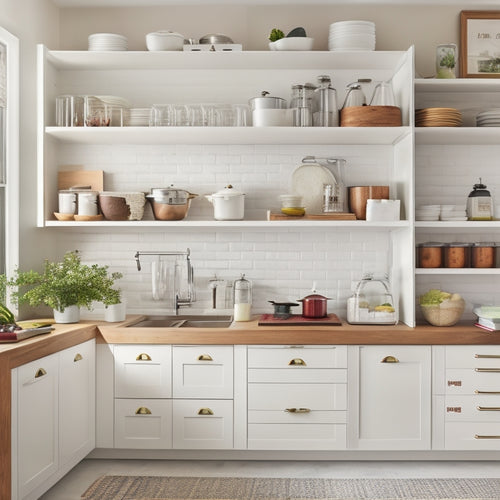
Building a Toilet Shower Room for Accessibility
Share
You're building a toilet shower room with accessibility in mind, which means carefully evaluating the specific needs of users who require extra support, clearance, and safety features to confidently and independently maneuver the space. Start by analyzing user needs to identify mobility challenges, then prioritize a spacious, open shower design with roll-in access, slip-resistant flooring, and proper lighting. Confirm the toilet is installed at a comfortable height with grab bars strategically placed for maximum support. As you move forward, you'll want to reflect on additional features like emergency alert systems, wheelchair-accessible dimensions, and shower seating options to create a truly inclusive space that accommodates all users.
Key Takeaways
- Prioritize a spacious, open design for the shower area with a roll-in shower and low-threshold entrance to eliminate tripping hazards.
- Ensure the toilet installation meets accessibility standards, with a height between 17 and 19 inches, and a floor-mounted toilet flange for stability.
- Install grab bars strategically, including vertical, horizontal, and angled bars, to provide optimal support and safety for users.
- Select slip-resistant flooring options, such as textured vinyl or ceramic tiles, and consider non-slip coating solutions for enhanced safety.
- Incorporate accessible dimensions, including a minimum door width of 32 inches and a wheelchair turning radius of 60 inches, to ensure easy navigation.
Assessing Accessibility Needs
When designing a toilet shower room for accessibility, you must first assess the specific needs of the individuals who'll be using the space. This user needs assessment helps you identify the unique challenges your users face, ensuring your design caters to their requirements.
For instance, do they've mobility challenges that require extra support or clearance? Do they need grab bars, seating, or non-slip flooring to maneuver the space safely?
Consider the user's mobility, strength, and dexterity when evaluating their needs. Ask yourself: Can they stand for extended periods or do they need a seat? Do they require assistance with transfers or can they move independently?
What's their reach and grip strength like? By understanding these factors, you can design a space that accommodates their needs, providing independence and confidence.
Designing the Shower Area
The shower area's layout and features play an indispensable role in guaranteeing a safe and comfortable experience for users with mobility or dexterity impairments.
You'll want to prioritize a spacious, open design that allows for easy entry and exit, as well as sufficient room for a caregiver to assist if needed. Consider a roll-in shower with a low or zero-threshold entrance to eliminate tripping hazards.
Proper shower lighting is essential for users with visual impairments. Install bright, LED lights that provide ample illumination, and consider adding a nightlight for added safety.
Additionally, confirm the shower floor is slip-resistant to prevent falls. Effective water drainage is also critical to prevent water accumulation and slipping hazards.
Install a shower drain that's designed for accessibility, such as a linear drain or a trench drain, which allows for a flat, even floor.
Toilet Installation Considerations
You'll need to carefully plan the toilet installation to ascertain it's accessible and comfortable for users with mobility or dexterity impairments. A vital aspect is toilet height, which should be between 17 and 19 inches above the floor to facilitate easy transfer from a wheelchair. This increased height also helps users with mobility issues to stand up and sit down more comfortably.
When it comes to plumbing requirements, make certain that the toilet is installed with a floor-mounted toilet flange, which provides a more stable and secure connection.
Additionally, consider using a toilet with a larger trapway (the curved pipe under the toilet bowl) to reduce clogging and make maintenance easier.
Don't forget to install the toilet at a comfortable distance from the wall, allowing for easy approach and transfer.
Grab Bar Placement Strategies
Having confirmed the toilet installation meets accessibility standards, it's now important to focus on grab bar placement strategies that facilitate safe and independent use for users with mobility or dexterity impairments. You'll want to take into account the types of grab bars and their installation heights to guarantee maximum support.
| Grab Bar Type | Installation Height |
|---|---|
| Vertical grab bars | 33-36 inches above floor |
| Horizontal grab bars | 33-36 inches above floor |
| Angled grab bars | 30-34 inches above floor |
| Floor-to-ceiling grab bars | Varies, but typically 30-40 inches above floor |
| Wall-to-wall grab bars | Varies, but typically 30-40 inches above floor |
When deciding on grab bar placement, take into account the user's comfort and ability to grasp the bar. For example, vertical grab bars are often preferred near toilets, while horizontal grab bars are better suited for shower walls. Don't forget to verify the grab bars are securely attached to the wall to support the user's weight. By carefully selecting and installing grab bars, you'll create a safe and accessible toilet shower room that promotes independence and confidence.
Slip-Resistant Flooring Options
When selecting flooring for your toilet shower room, you'll want to choose materials that provide traction and stability underfoot.
You'll need to take into account flooring material options like textured vinyl, rubber, or ceramic tiles with non-slip glazes.
Additionally, you can also investigate non-slip coating solutions that can be applied to your chosen flooring material to further enhance its slip-resistance.
Flooring Material Options
Three primary considerations drive the selection of flooring material for a toilet shower room designed for accessibility: safety, durability, and ease of maintenance.
You want a floor that's safe for users who may have mobility issues, durable enough to withstand heavy use, and easy to clean to prevent water damage and bacterial growth.
When it comes to safety, you'll want to opt for flooring materials with textured surfaces or those that provide traction.
Vinyl and rubber flooring are excellent options, as they're slip-resistant and gentle on joints. Eco-friendly materials like cork and bamboo are also great choices, as they're sustainable and provide natural traction.
If budget is a concern, consider cost-effective options like ceramic or porcelain tiles.
These materials aren't only affordable but also easy to clean and maintain. Additionally, they can be designed to mimic the look of natural stone, giving your toilet shower room a luxurious feel without the hefty price tag.
Whatever material you choose, make sure it meets your accessibility needs and fits your budget.
Non-Slip Coating Solutions
Your toilet shower room's flooring material is only half the battle when it comes to preventing slips and falls. The other half is all about the non-slip coating solutions you apply to that flooring.
Think of it as adding an extra layer of protection to guarantee your bathroom doesn't become a slip-n-slide zone. You've got several options to choose from, including non-slip materials like textured coatings, treads, and mats. These can be applied directly to your flooring material, providing extra grip and traction.
Surface treatments are another way to go, with options like chemical etching, shot blasting, or applying a non-slip finish. These treatments change the surface texture, making it more slip-resistant.
When selecting a non-slip coating solution, consider factors like durability, maintenance, and aesthetics. You want a solution that not only provides traction but also complements your bathroom's design.
Wheelchair Accessible Dimensions
In designing a wheelchair accessible toilet shower room, you'll need to contemplate the spatial requirements that guarantee safe and comfortable passage. One essential aspect is ensuring that the space can accommodate a wheelchair's turning radius. You don't want your users to get stuck in a corner, do you?
When it comes to door width requirements, you should aim for a minimum of 32 inches (81 cm) to allow for easy wheelchair access. But that's not all - the floor space within the room is equally important. Here's a breakdown of the minimum dimensions you should consider:
| Area | Minimum Dimension |
|---|---|
| Wheelchair turning radius | 60 inches (152 cm) |
| Door width | 32 inches (81 cm) |
| Floor space | 60 inches x 60 inches (152 cm x 152 cm) |
Shower Seat and Bench Options
You'll want to contemplate the type of material used for the shower seat, as it can impact durability, maintenance, and comfort.
For instance, phenolic resin seats are resistant to mold and mildew, while solid surface seats can be more comfortable.
Additionally, fold-down shower benches can be a great space-saving option, providing a convenient place to sit while showering without taking up essential floor space when not in use.
Seat Material Options
Selecting the right seat material for your shower seat or bench is essential, as it directly impacts comfort, safety, and maintenance. You'll want a material that's both durable and easy to clean, as a slippery or grimy seat can be a major hazard.
When it comes to seat durability, you'll want to evaluate materials like stainless steel, aluminum, or PVC-coated metal. These options are resistant to corrosion and can withstand the humid shower environment.
For seat aesthetics, you might prefer materials like teak, phenolic, or recycled plastic. These materials offer a more natural look and can add a touch of warmth to your shower space. However, keep in mind that they may require more maintenance than their more durable counterparts.
Ultimately, you'll need to strike a balance between form and function. Assess your personal preferences, budget, and maintenance capabilities when choosing the perfect seat material for your shower seat or bench.
Fold-Down Shower Benches
Having chosen the right seat material, it's time to contemplate the type of shower bench that will best suit your needs.
Fold-down shower benches are an excellent option, especially if you're short on space or want to create a more open feel in your toilet shower room. These benches are mounted to the wall and can be easily folded up against the wall when not in use, freeing up floor space.
When selecting fold-down shower benches, consider the fold-down materials. Look for sturdy, water-resistant materials like stainless steel, aluminum, or heavy-duty plastic.
Verify the bench is designed for your weight capacity and can support the user comfortably. Also, think about bench maintenance – will it be easy to clean and maintain? A bench with a smooth, non-porous surface and a slight slope for water drainage is ideal.
Additionally, consider the fold-down mechanism – is it easy to operate, and will it withstand frequent use? By choosing the right fold-down shower bench, you'll create a safe, accessible, and convenient showering experience.
Water Temperature Control Systems
A temperature-control system is the heart of a safe and comfortable toilet shower room, as it prevents scalding and guarantees a pleasant bathing experience. You want a system that's not only dependable but also easy to use, especially for users with disabilities.
Look for smart thermostatic controls with user-friendly interfaces that allow you to set your preferred temperature with ease. Energy-efficient systems are essential, as they'll save you money on your water heating bill.
With remote temperature monitoring, you can keep an eye on the water temperature from anywhere, making certain it stays within safety temperature limits. Digital control panels make it easy to adjust the temperature, and some systems even offer instant hot water, so you don't have to wait for the water to heat up.
Temperature stability solutions guarantee the water temperature remains consistent, and adaptive temperature settings allow you to customize the temperature to your liking. With user customization options, you can create a bathing experience that's customized to your needs.
Emergency Alert System Integration
As you design your toilet shower room for accessibility, you're likely thinking about more than just water temperature control. You're thinking about safety, and that's where emergency alert system integration comes in. This feature is vital for individuals who may need assistance in the shower room, especially in emergency situations.
When selecting an emergency alert system, take into account the alert signal types that best suit the user's needs. For example, visual alerts like flashing lights or strobe lights can be effective for individuals with hearing impairments. Auditory alerts like sirens or buzzers can be used for those with visual impairments.
You may also want to take into account tactile alerts, such as vibrating devices, for users who require a more hands-on approach.
It's important to pair your emergency alert system with established emergency response protocols. This guarantees that when an alert is triggered, the appropriate personnel or caregivers are notified and respond promptly.
Frequently Asked Questions
How Do I Ensure Adequate Ventilation in the Toilet Shower Room?
You'll want to prioritize ventilation options to avoid a steamy space. Guarantee good air circulation by installing an exhaust fan, and consider a heat-recovery ventilation system or a solar-powered ventilation system for a more eco-friendly option, don't you think?
Can I Install a Toilet Shower Room in a Small Bathroom?
You can squeeze a toilet shower room into a small bathroom if you're clever about space optimization, but don't forget to take into account plumbing considerations, like where you'll hide the pipes, or you'll end up with a messy, cramped space!
What Are the Benefits of Using a Macerator Toilet System?
You'll love the macerator toilet system! Its advantages include space-saving design, quiet operation, and ease of installation. Plus, its features like powerful grinding and self-cleaning technology make it a practical, low-maintenance option for you.
Are There Any Specific Cleaning Products Recommended for Toilet Shower Rooms?
When cleaning your toilet shower room, you'll want to grab eco-friendly cleaners that are gentle on surfaces and the environment, plus disinfectant options that'll leave your space sparkling and germ-free - all while keeping your sense of humor intact!
Can I DIY a Toilet Shower Room Installation or Hire a Professional?
You've tackled DIY projects before, but a toilet shower room installation is a different beast. Take Sarah, who tried to DIY and ended up with a flooded bathroom due to incorrect plumbing considerations. Hire a pro to guarantee a smooth toilet layout and stress-free installation.
Conclusion
As you step into your new toilet shower room, the harmony of accessibility and design comes alive. Like a puzzle, every piece falls into place, ensuring a safe and independent experience. The grab bars, like outstretched arms, offer support and balance. The slip-resistant floor, a gentle whisper, reassures each step. Every detail, a brushstroke on the canvas of independence, paints a portrayal of freedom and confidence. Your new space is a sanctuary, where accessibility meets serenity.
Related Posts
-

Small Bathroom Waterproof Storage Ideas
In a small bathroom, you've got to get creative with waterproof storage solutions to keep things organized and dry. C...
-

Revolutionize Your Kitchen With Shelfgenie Installation
I'm on a mission to revolutionize my kitchen with Shelfgenie installation, and I'm loving the results! With a seamles...
-

Innovative Miro Applications: Beyond the Usual
Miro's capabilities surpass traditional boundaries, offering a domain of innovative applications waiting to be explor...


